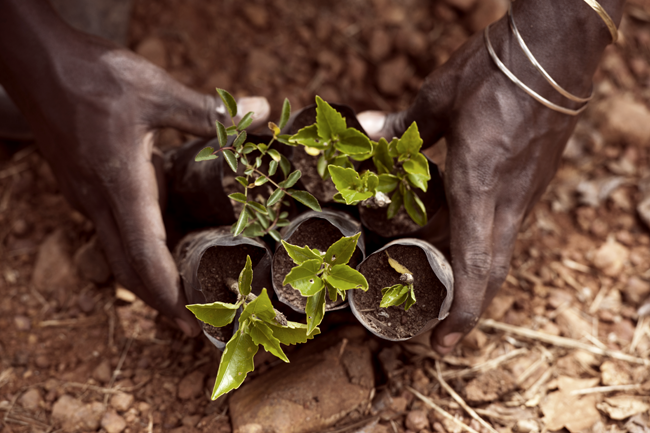Across Africa, 70% to 80% of agricultural production is done by smallholder farmers on an average plot size of 2.5 ha. There are exceptions, but a considerable number of farmers lack access to suitable production inputs, quality infrastructure, finance and technology and an efficient agriculture supply chain. Nor do they have the necessary skills to take full advantage of the support and technology available to them, says World Bank Group senior agribusiness specialist for trade and competitiveness Augustine Langyintuo.
Speaking at the Africa Farm Management Association conference in Cape Town in late 2014, Langyintuo said there was much scope to train farmers and equip them with the skills they need to perform better.
At the same conference, Usman Haruna, from the Federal University Dutse in Nigeria, presented a paper on sustainability and agricultural development in Nigeria. Quoting data from the International Fund for Agricultural Development (IFAD), he said that 75% of the world’s 1.2 billion poor (defined as consuming less than one purchasing-power adjusted dollar per day) live and work in rural areas, where agriculture is the principle economy.
In sub-Saharan Africa, 73% of the rural population are smallholder farmers. It follows then that a large proportion of small-scale farmers in sub-Saharan Africa are among the poorest of the poor.
Furthermore, despite receiving various forms of agricultural support through the private and public sectors, the situation of smallholder farmers in the region has made very little progress over the past decade.
According to a paper presented at a 2011 IFAD conference on the future of smallholder agriculture, one of the key challenges is that farmers lack the competitiveness to find a way out of poverty through farming because their productivity levels are not high enough.
The paper’s authors – Sara Delaney, Steven Schonberger and Geoffrey Livingston – suggest that to address this issue, smallholder-farmer development has to focus on ‘increased on-farm investments, such as appropriate seeds and fertilisers, irrigation and mechanisation technologies’.
Despite recent advances, sub-Saharan Africa remains well behind other regions with regard to the use of improved seeds and fertilisers. According to Langyintuo, sub-Saharan Africa has seen an average adoption rate of improved seeds of only 28%. Africa uses approximately just 3% of all fertiliser globally.
In the paper, Delaney, Schonberger and Livingston also refer to statistics showing that, on average, farmers in sub-Saharan Africa applied less than 10 kg of nutrients/ha, compared with around 140 kg/ha in both Latin America and South Asia.
In addition, over the last 50 years, the share of cultivated land under irrigation in Asia increased from 27% to 36%. In sub-Saharan Africa, however, less than 3% of cultivated land was under irrigation.
Sub-Saharan Africa also lags behind other regions in the adoption of new mechanisation technology. According to the paper, only 15 tractors were in use per 100 km², compared with around 170 per 100 km² in East- and South-Asian countries. Latin America had 100 per 100 km².
Apart from the on-farm investment gap, there’s another reason why agricultural support programmes have not been very effective. To some extent farmers are indeed being given inputs and access to new technology. However, a key challenge is that they are not always equipped with the skills required to productively apply the improved inputs and techniques.
This is according to Afenyo Selasi, a senior technical advisor at GrisPro & Co, a Ghanaian company that provides technical advice and management support to smallholder farmers. The former IFAD consultant authored a paper titled Making Small-scale Farming Work in Sub-Saharan Africa, in which he identified the main issues that have contributed to the poor performance of smallholder farming in the region. Selasi draws attention to the critical need for skills training, or the ‘re-tooling’ of smallholder farmers.
Deprived of new skills, smallholder farmers, lack the ‘knowledge to respond to their ever-evolving circumstances’, he says. They are being assisted with ‘new technologies, extension programmes, inputs such as seeds, fertiliser and agrochemicals, they are being introduced to new varieties of crops and farming methodologies, attempts are being made to link them to markets and credit services and they are being equipped to respond to climate change’.
These developments are positive but they fail to adequately address the underlying issue: ‘the need of farmers for new abilities and capabilities’. Their inability to respond to fast-changing demands in global food production, especially in terms of food quality and safety standard, means that smallholder farmers are losing market share.
‘Because markets do not respond to needs but to demands, small-scale farmers must necessarily produce to meet market demands. These demands are getting tougher and meeting them will increasingly require new knowledge and skill, which small farmers do not readily possess,’ he writes.
Across Africa, 70% to 80% of agricultural production is done by smallholder farmers on an average plot size of 2.5 ha
Selasi adds that rural farming areas were in dire need of facilities where smallholder farmers could be taught basic literacy, which would help them successfully adopt technologies and make better informed business decisions.
According to a 2014 Initiative for Small-holder Finance report, technical assistance programmes could help these farmers improve their agronomic skills, business and financial skills, and access to markets. ‘Given there are 450 million smallholder farmers in developing countries, this amount translates to just US$18.66 per smallholder farmer per year,’ the report states.
However, it’s not all doom and gloom. Many projects run by African governments and other institutions have already proven how successful smallholder development programmes can be when they incorporate skills training.
Take Rwanda for example. According to the IFAD, ‘total production of maize, wheat and cassava tripled, bean production doubled, and rice and Irish potato production increased by 30%’ between 2007 and 2011 as a result of the country’s crop intensification programme. However, while farmers began producing better yields and harvest for longer periods of the year, much of the produce was going to waste as significant post-harvest losses occurred due to a variety of climate-induced stresses.
In a bid to reduce these losses, the Rwandan government partnered with the IFAD in early 2014 to launch the Climate Resilient and Post-harvest Agribusiness Support Project (PASP).
Through the project, smallholder farmers are given opportunities to gain the skills, knowledge and access to specialised service providers that they need to be able to ultimately deliver larger volumes of better-quality produce to the market.
The project also equips farmers with the means and skills to manage climate risks in the post-production process, as well as storage techniques. PASP aims to reach over 32 400 rural households (155 518 people) in 10 districts in the country’s northwest, southern and eastern regions.
An Aid by Trade Foundation (AbTF) initiative is helping smallholder cotton farmers in Cameroon, Côte d’Ivoire, Ghana, Malawi, Mozambique, Zambia and Zimbabwe. Its Cotton made in Africa (CmiA) project provides training programmes that ‘teach smallholder farmers about efficient and environmentally friendly cultivation methods according to the sustainability criteria of the CmiA standard’.
These measures focus primarily on soil fertility and alternatives to artificial irrigation. This ensures that the cotton produced has a much smaller ecological footprint than conventionally grown cotton, and that farmers achieve increased yields.
In 2009, around 145 000 smallholder farmers were participating in the CmiA initiative, and this number is expected to reach 650 000 this year. It has also seen a considerable increase in production, from 83 000 tons of lint cotton on 290 000 ha of land in 2010/ 2011 to more than 142 500 tons produced on 578 600 ha in 2013.
The sustainably produced cotton is marketed via a global alliance of demand partners comprising more than 20 textile firms.
‘The licensing fees for CmiA-certified cotton paid by the demand partners are reinvested in the growing regions as well as for agricultural training and certification costs to benefit smallholder farmers in the project countries,’ says the AbTF.
The foundation also runs ‘farmer business schools’ where basic skills are taught.
In a project funded by the former Canadian International Development Agency, smallholder farmers in Mwanza, Tanzania, received skills training in food-processing techniques, which has help to reduce their post-harvest losses.
Training provided by the Agency for Co-operation and Research in Development (ACORD) and the Small-scale Industries Development Organisation, taught small-holder farmers to enhance the market value of local produce, reduce wastage and improve the nutritional value of produce through various techniques, as well as about food processing and preservation.
According to ACORD: ‘More than 300 small-scale farmers have so far benefited directly from the initiative, and it is expected that a multiplier effect will enable thousands more from across Tanzania to benefit from the skills acquired by the trainees.’
Projects such as these will hopefully inspire increased spending on smallholder development initiatives that offer not only input and marketing assistance, but also much-needed skills training.
By Alida van Heerden
Image: Gallo/GerryImages


